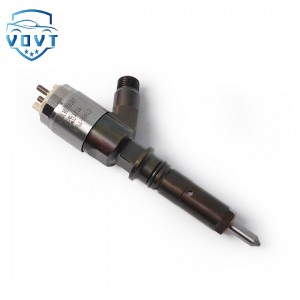New High Quality Diesel Injector 356-1367 20R-9945 374-0750 20R-2284 CH11945 For CAT C15
Products Description
| Reference. Codes | C15 |
| Application | C15 |
| MOQ | 4PCS |
| Certification | ISO9001 |
| Place of Origin | China |
| Packaging | Neutral packing |
| Quality Control | 100% tested before shipment |
| Lead time | 7~10 working days |
| Payment | T/T, L/C, Paypal, Western Union, MoneyGram or as your requirement |
How to test and optimize the flow characteristics of fuel injectors?
Test method
Steady-state flow test
Test equipment: Usually use the injector flow test bench. The test bench is mainly composed of a fuel tank, a fuel pump, a pressure regulating valve, a flow meter, a temperature control system and a test fixture.
Test process: Install the injector on the test fixture, pump the fuel from the fuel tank through the fuel pump, adjust the pressure regulating valve to the set injection pressure, and measure the fuel flow rate within a certain period of time through the flow meter after the fuel flows through the injector. At the same time, use the temperature control system to keep the fuel temperature stable to eliminate the influence of temperature on fuel density and viscosity, and ensure the accuracy of the test results. By changing the injection pressure and injection time, record the fuel flow data under different working conditions, and obtain the steady-state flow characteristic curve of the injector.
Dynamic flow test
Test equipment: Common is a dynamic flow test system based on high-speed photography technology or laser measurement technology. For example, the laser phase Doppler velocimeter (PDA) can accurately measure the velocity and particle size distribution of oil droplets during fuel injection, and then deduce the instantaneous flow rate of the fuel.
Test process: In the bench test of actual engine operation or simulated actual operation, the above test equipment is used to monitor the fuel injection process of the injector in real time. Through high-speed photography or laser measurement, the injection state and parameters of the fuel at different times during the injection process are obtained, and the dynamic flow characteristics of the injector are analyzed, including the injection start point, injection end point, injection rate change and other information.
Optimization method
Optimize the injector structure
Nozzle parameter optimization: Optimize the flow characteristics by changing the number, diameter, length and shape of the nozzles. For example, increasing the number of nozzles can make the fuel more evenly dispersed and improve the atomization effect, but it may affect the flow of a single nozzle; reducing the nozzle diameter helps to improve the quality of fuel atomization, but too small nozzles are prone to clogging. It is necessary to comprehensively consider the engine's operating conditions and fuel quality to determine the appropriate nozzle parameters.
Needle valve structure optimization: Improve the design of the needle valve, such as optimizing the needle valve lift curve, increasing the opening and closing speed of the needle valve, etc. Reasonable needle valve lift curve can make the injection rate better meet the combustion requirements of the engine under different working conditions; fast needle valve opening and closing can reduce injection delay and dripping, and improve injection accuracy and stability of flow characteristics.
Adjust injection strategy
Injection pressure adjustment: optimize injection pressure according to engine working conditions and fuel characteristics. Under high load conditions, appropriately increasing injection pressure can increase fuel injection volume and improve atomization effect, and improve combustion efficiency; under low load conditions, reduce injection pressure to avoid excessive fuel injection and waste. Modern common rail fuel injection systems use electronic control units (ECUs) to accurately adjust the fuel pressure in the common rail to optimize injection pressure under different working conditions.
Injection time optimization: accurately control the injection time and injection duration. According to parameters such as engine speed, load, and intake volume, the ECU calculates the best injection time. For example, when the engine is cold started, appropriately advancing the injection time can improve the evaporation and mixing of the fuel and improve the starting performance; under partial load conditions, optimizing the injection duration can fully mix the fuel and air and reduce the emission of incomplete combustion products.
Optimization based on test data
Data analysis and modeling: Detailed analysis of the flow characteristic data obtained from the test is carried out to establish a mathematical model of the injector flow characteristics. Through methods such as curve fitting and regression analysis, the quantitative relationship between flow and factors such as injection pressure, time, and nozzle parameters is found. The model can be used to predict the flow characteristics of the injector under different working conditions, providing a theoretical basis for optimization.
Iterative optimization: According to the results of data analysis and model prediction, the structural parameters or injection strategy of the injector are adjusted, and then the test is carried out again to compare the flow characteristic data before and after optimization to evaluate the optimization effect. Repeated iterations until the flow characteristics of the injector meet the performance and emission requirements of the engine.























